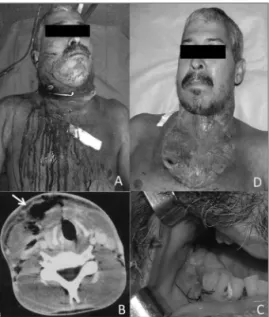805
Brazilian Journal of otorhinolaryngology 77 (6) novemBer/DecemBer 2011 http://www.bjorl.org / e-mail: revista@aborlccf.org.br
Cervical-thoracic facial necrotizing fasciitis of odontogenic origin
Rui Medeiros Júnior
1, Auremir da Rocha Melo
2, Hugo Franklin Lima de Oliveira
3, Silvana Maria Orestes
Cardoso
4, Carlos Augusto Pereira do Lago
51 Oral and maxillofacial surgery and trauma specialist, Hospital da Restauração, Recife, PE. Oral and maxillofacial surgeon. 2 Oral and maxillofacial surgery and trauma specialist, Hospital da Restauração, Recife, PE. Oral and maxillofacial surgeon.
3 Medical resident in oral and maxillofacial surgery, Hospital da Restauração, Recife, PE. Dental surgeon.
4 Doctoral degree in oral biology, Paris VII University, France. Professor of the Orofacial Surgery and Prosthesis Department, Pernambuco Federal University, UFPE, Recife, PE. 5 Doctoral de gree in oral and maxillofacial surgery and trauma, Pernambuco Denistry School (FOP), UPE. Staf of the Oral and Maxillofacial Surgery and Trauma Unit, Hospital da
Restauração, Recife, PE.
Restauracao Hospital (Hospital da Restauração).
Send correspondence to: Rua Dr. Geraldo de Andrade, 101, apto. 104. Espinheiro, Recife - PE. CEP: 52021-220. Paper submited to the BJORL-SGP (Publishing Management System – Brazilian Journal of Otorhinolaryngology) on May 17, 2010;
and accepted on July 12, 2010. cod. 7090
CASE REPORT
Braz J Otorhinolaryngol. 2011;77(6):805.
BJORL
Keywords:
face, fasciitis, necrotizing, infection.
.org
INTRODUCTION
Necrotizing fasciitis (NF) of the head and neck is a rare and potentially fatal soft tissue bac-terial infection that affects mostly male and female
adult and elderly patients.1 There are no reliable
data on its true incidence in the population.2
The origin is odontogenic in most cases, resulting from dental abscesses, chronic periodontal disease, or pharyngeal diseases. It progresses by forming extensive necrosis and gas in subcutaneous tissues and the underlying fascia, and has a high
mortality rate (about 40%).2
This disease is usually polymicrobial; such cases may be classified into type I, when caused by a mixed flora consisting of obligate anaerobic bacteria and other facultative anaerobic organisms not belonging to group A, and type II, when group A Streptococcus singly or with Staphylococcus aureus is involved.3
Risk factors for NF are uncontrolled dia-betes mellitus, peripheral vascular disease, liver
diseases, and immune diseases.2 Imaging is
essen-tial to define the topography of the infection; the differential diagnosis is made mostly with cellulitis and initial stage erysipela.4 Successful treatment
requires an early diagnosis, radical surgical debri-dement of all necrotic tissues, endovenous broad-spectrum antibiotic therapy, and aggressive general
support measures.4
CASE REPORT
A male patient aged 37 years with a his-tory of chronic alcohol abuse presented a facial-cervical-thoracic lesion that suggested cellulitis, and a history of untreated dental infection.
On the physical examination, there was mandibular trismus, the submandibular, sublin-gual, and submentonian regions were enlarged, painful, and hardened bilaterally; this extended to the thorax (Fig. 1A). An oral examination showed several remaining tooth roots, teeth with caries, and periodontal disease. Hyperemia, hyperthermia, tachypnea, dehydration, and leukocytosis indicated sepsis. Computed tomography revealed a characte-ristic subcutaneous emphysema (Fig. 1B).
Emergency treatment was started, invol-ving radical surgical debridement. During surgery, material was taken and sent for culture and an
antibiogram. The anterior neck and thoracic mus-cles were left exposed. Multiple removal of teeth were done to remove the primary disease (Fig. 1C).
Antibiotic therapy was started empirically with ceftriaxone and metronidazole. The culture
revealed Klebsiella pneumoniae and antibiotic
sensitivity testing showed that it was sensitive to the aforementioned antibiotics. Additional smaller areas were debrided during the first two weeks after surgery (Fig. 1D).
DISCUSSION
The present study presents a case of NF of odontogenic origin in a patient with chronic alcohol abuse, which progressed rapidly to the neck and thorax. Whitesides et al.5 reported that 81% of such
cases start from the second or third inferior molars. Kaul et al.6 studied 77 cases and found at least one
underlying disease in over 70% of them. The diagnosis of NF is essentially medical (based on non-elastic skin edema, hypoesthesia,
subcutaneous crepitus, etc.). It is confirmed during surgery by noting poor adherence of subcutaneous tissues, lack of bleeding, and necrosis of the fascia.
Emergency surgery was done after computed tomography showed a characteristic subcutaneous emphysema and revealed the true extent of the infection. Aggressive debridement was done of the neck and thorax; the procedure reached the mammillary line, the midpoint of the clavicle bilaterally, and the base of the mandible. The findings at surgery included a decreased re-sistance to dissection, necrosis in deeper layers of the fascia, necrosis of the skin and subcutaneous tissue, drainage of pus, and a fetid odor, which sealed the diagnosis of NF.
A rare finding was Klebsiella pneumoniae
as a single causative bacteria, which is not typical of the classic polymicrobial pattern of infection. An-tibiotic therapy was effective in this case. Adjuvant measures, such as immunoglobulins and hyperbaric
oxygen therapy, are also currently employed.3
FINAL COMMENTS
Rarely oral infection may cause severe and even fatal NF. This condition progresses rapidly, especially when associated with predisposing fac-tors. The treatment requires a prompt diagnosis, broad-spectrum antibiotic therapy, and radical surgery. A multidisciplinary team is recommended in many cases.
REFERENCES
1. Ord R, Coletti D. Cervico-facial necrotizing fasciitis. Oral Dis. 2009;15(2):133-41.
2. Kuncir EJ, Tillou A, St Hill CR, Petrone P, Kimbrell B, Asensio JA. Necrotizing soft-tissue infections. Emerg Med Clin North Am. 2003;21(4):1075-87. 3. Wolf H, Ovesen T. Necrotizing fasciitis in
the head and neck region. Ugeskr Laeger. 2008;170(34):2563-6.
4. Costa IMC, Cabral ALSV, Pontes SS, Amorim JF. Fasciíte necrosante: revisão com enfoque nos aspectos dermatológicos. An Bras Dermatol. 2004;79(2):211-24.
5. Whitesides L, Cotto-Cumba C, Myers RA. Cervical necrotizing fasciitis of odontogenic origin: a case report and review of 12 cases. J Oral Maxillofac Surg. 2000;58(2):144-51.
6. Kaul R, McGeer A, Low DE, Green K, Schwartz B. Population-based surveillance for group A streptococ-cal necrotizing fasciitis: Clinical features, prognostic indicators, and microbiologic analysis of seventy-seven cases. Am J Med. 1997;103(1):18-24.
